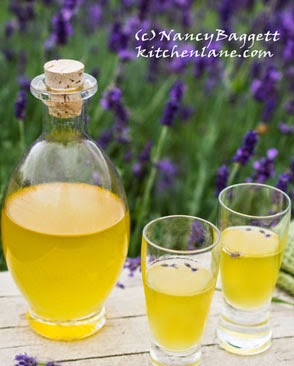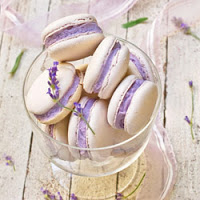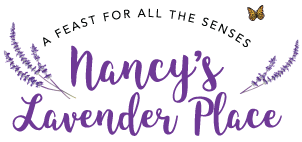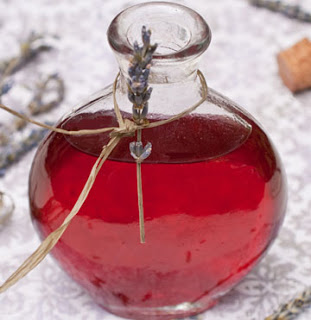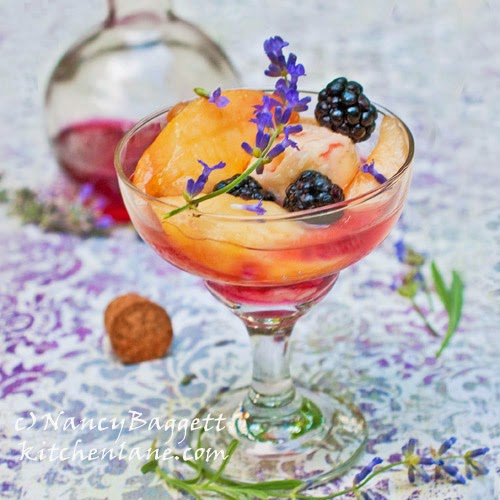 It’s said that aromas can remain with us and trigger memories for a lifetime. I know this is true. I clearly remember the clean, sweet herb scent of lavender sachets wafting up whenever my beautiful, gentle mother slid open the drawers or her highboy dresser or dabbed Yardley English Lavender cologne behind her ears. And though she died far too young (and deeply mourned) more than forty years ago, just a whiff of lavender in my garden or kitchen today instantly calls her up—still vibrant and in good health—in my mind’s eye. I wish she were around to sit and enjoy this Lavender Blackberry Syrup drizzled over a dish of fruit with me right now.
It’s said that aromas can remain with us and trigger memories for a lifetime. I know this is true. I clearly remember the clean, sweet herb scent of lavender sachets wafting up whenever my beautiful, gentle mother slid open the drawers or her highboy dresser or dabbed Yardley English Lavender cologne behind her ears. And though she died far too young (and deeply mourned) more than forty years ago, just a whiff of lavender in my garden or kitchen today instantly calls her up—still vibrant and in good health—in my mind’s eye. I wish she were around to sit and enjoy this Lavender Blackberry Syrup drizzled over a dish of fruit with me right now.
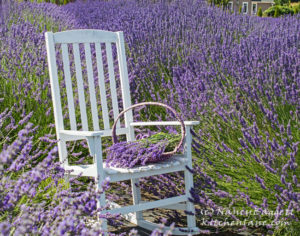
With such an intensely pleasant association, I would have to love lavender. (See another post and recipe here.) But it’s only in the last several decades that I’ve enjoyed it in more than sachets, soaps, and perfumes. Since my mother didn’t grow any herbs in her garden, I started out knowing almost nothing other than that the dried herb was aromatic and that the distinctive purple flowers pictured in the romantic, Victorian-style images on her lavender bath products were charming.
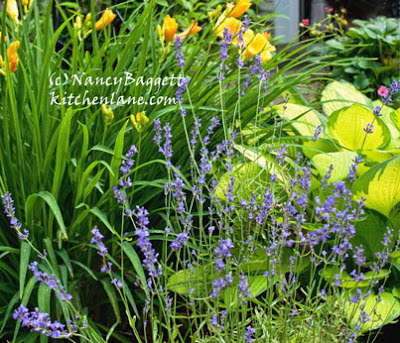 A whole succession of English regents used lavender. Queen Elizabeth I reportedly had a sweet tooth and always had a lavender conserve at hand to enjoy. Later, Queen Victoria used it lavishly and was largely responsible for its enormous popularity in the 19th century, as this quote from an 1895 book, Fragrant Flowers, suggests: “The royal residences are strongly impregnated with the refreshing odour of this old-fashioned flower, and there is no perfume that the Queen likes better than Lavender-water, which, together with the oil for disinfecting purposes, Her Majesty has direct from a lady who distills it herself.”
A whole succession of English regents used lavender. Queen Elizabeth I reportedly had a sweet tooth and always had a lavender conserve at hand to enjoy. Later, Queen Victoria used it lavishly and was largely responsible for its enormous popularity in the 19th century, as this quote from an 1895 book, Fragrant Flowers, suggests: “The royal residences are strongly impregnated with the refreshing odour of this old-fashioned flower, and there is no perfume that the Queen likes better than Lavender-water, which, together with the oil for disinfecting purposes, Her Majesty has direct from a lady who distills it herself.”
The association of lavender with antimacassar lace and staid Victorian ladies, plus the arrival of more and more seemingly magical chemical air fresheners, deodorants, and disinfectants after 1900 doubtless account for it gradually falling out of favor in the second half of the 20th century. Up until the last twenty years or so, at least in the mid-Atlantic region, only a few herbalists and specialty growers were carrying lavender, and even fewer sold fresh blooms or live plants. Dried lavender was marketed almost exclusively for soap and candle crafting and very rarely suggested as an ingredient in cooking.
Now, thank goodness, this glorious herb is making a comeback, having captured the fancy of 21st century aromatherapy and culinary fans, as well as those suspicious of chemical additives and turning to natural enhancers again. It’s also turning up as a garden ornamental, though in central Maryland where I live cultivation is a bit of a challenge: The soil is heavy and mostly clay, and lavenders like it light and sandy. And much of my yard is shady, and lavenders prefer full sun. Many of the so-called English lavenders that are best suited for culinary use whither from our intense summer heat and then often killed by our occasional hard winter freezes.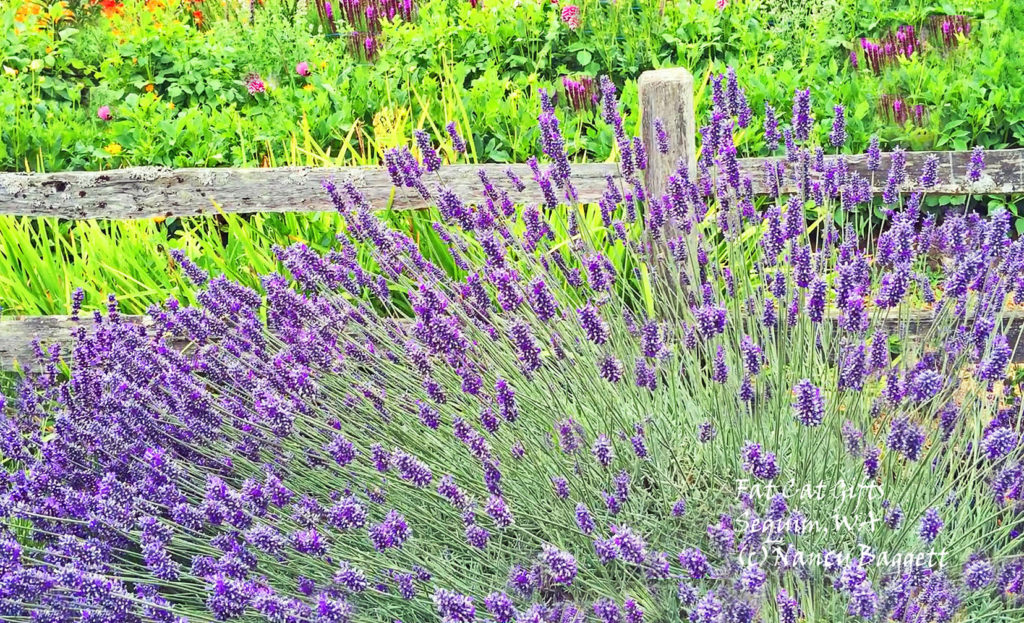
Some of my West Coast foodie friends report that lavender grows like a weed for them; dare I say I’m green–make that purple!–with envy! (The shot with the rocking chair was take at the Lavender Connection (aka Creekside Farm) in Sequim, WA, where the lavender is spectacular; the pic at left was taken at Fat Cat Gifts, also in Sequim, WA.) But so far the only variety I’ve found that thrives here in summer and survives the winter left in the ground (usually, if well mulched) is a hybrid variety developed specifically for my region called Phenomenal. But, I’ve had better luck growing the so-called English lavenders on my son’s property–the soil is sandier, has better drainage and the plants get sun all day long.
About ten years ago, I began experimenting with lavender in the kitchen and only wish I’d done so sooner. In recipes such as the lavender blackberry syrup here it adds a haunting, almost addictive dimension to fruit and berry recipes, especially ones featuring berries, peaches or lemons. Try tossing in a couple lavender heads to infuse poached berries, or a sorbet mixture, or jelly or jam; fish them out when the cooking is done. Lavender is also excellent in pork dishes, and some beef and chicken recipes as well. Add some finely crushed dried buds to a honey sweet and sour sauce or glaze.
 Note that the bracts and tiny blooms they hold, not the leaves, are the best parts of this herb for cooking. Also, be sure to purchase “culinary” or “angustifolia” lavender for cooking purposes. Varieties labeled “stoeches,” (aka Spanish) or “dentata,” (aka tooth-leafed) are strong and too bitter tasting to eat.
Note that the bracts and tiny blooms they hold, not the leaves, are the best parts of this herb for cooking. Also, be sure to purchase “culinary” or “angustifolia” lavender for cooking purposes. Varieties labeled “stoeches,” (aka Spanish) or “dentata,” (aka tooth-leafed) are strong and too bitter tasting to eat.
I don’t claim that this syrup has any medicinal properties whatsoever, it just tastes uniquely herbal-floral and pleasing. Splash or drizzle this syrup over mixed fruit compotes, or dishes of berries, melon, peaches or sliced nectarines. Add a little scoop of ice cream or sorbet and perhaps a pedestal serving dish, for light and simple, yet elegant sundaes or fruit cups like the one shown here. And do experiment with stirring a little syrup into hard or soft beverages; it is particularly winning paired with lemon drinks of all sorts.
Depending on the variety, brand, and degree of freshness, dried lavender can be fairly mild or boldly flavored to the point of being overpowering. Take a sniff and then add in between 1 and 1½ tablespoons, as seems appropriate. Note that the blackberries are mostly incorporated for color. If desired, you can leave them out, in which case the syrup will have very pale grayish-lavender color instead.
- ¾ cup granulated sugar
- ¾ cup water
- 2 tablespoons clover honey, optional
- 4 to 6 fresh blackberries, washed, drained, and mashed with a fork
- 1 to 1½ tablespoons dried culinary lavender buds
- Stir together the sugar, water, honey, and blackberries in a 1-quart saucepan over medium heat. Bring to a boil, stirring, then adjust the heat so the mixture boils gently. Cook, without stirring for 6 to 7 minutes until the berries soften and break apart. Remove from the heat. Stir in the lavender. Let stand so the lavender can more fully infuse the syrup 30 minutes or up to an hour for a bolder taste.
- Push the syrup through a fine sieve into a saucepan. Bring back to a boil for 1 minute. Pour into a sterilized bottle or jar. Let cool to room temperature and store, refrigerated, for up to 2 weeks. Makes about ⅔ cup syrup. The recipe can be doubled if desired.
This post is adapted from one originally posted at www.kitchenlane.com; the original is here. For a lavender buttercream recipe for cookies and French macarons go here. Or, to make a lavender-infused limoncello liqueur, go here.
